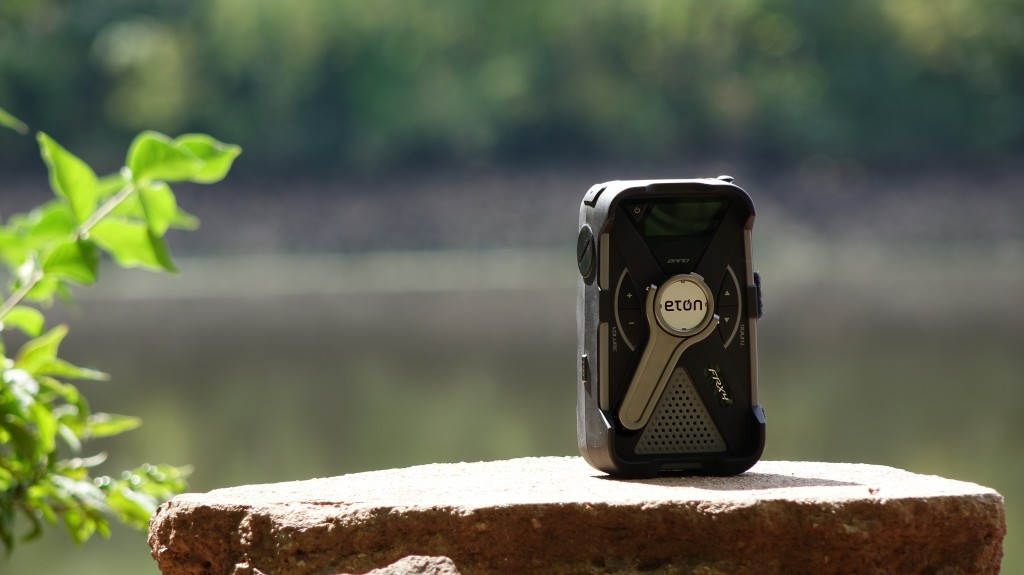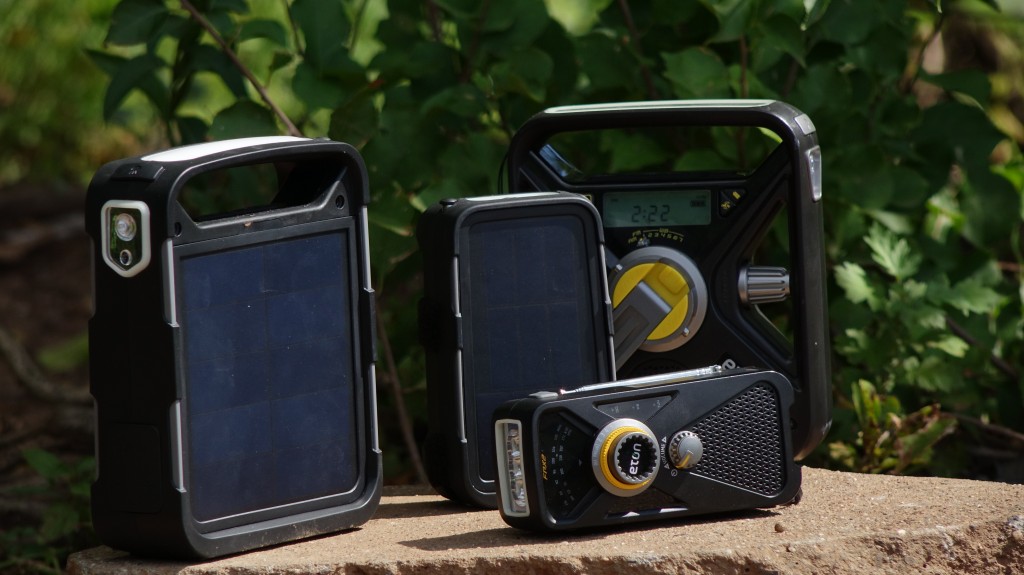
After an announcement at CES and a few shipping delays, I did eventually receive my Eton FRX4 and FRX5, updates to their existing FRX2 and FRX3 emergency products. I intentionally skipped over purchasing the FRX1 as it does not include a USB port for phone charging but is otherwise an FRX2.
All four products contain at least
- Handcrank
- Solar panel
- AM/FM/Weather radio
- USB out for charging cellphones
- USB in for charging themselves
- Headphones
- A built in speaker
- Telescoping antenna
- Flashlight
So any one of them and you technically will be somewhat better off than having no way to charge your phone or get the weather in an emergency. However, there is a huge difference in quality in the units that frustratingly isn’t a linear progression, so I’m going to break the review down by feature rather than unit.
As an AM/FM/Weather radio
The FRX2 not only has a dial tuner, it has crappy sound that is not improved by using headphones. I tried to listen to an AM broadcast of a football game and could barely follow it. The FRX3 FRX4 and FRX5 all have a digital tuner and much better built in speaker, although the FRX3 speaker is better than the smaller FRX4. The FRX5 uniquely has S.A.M.E. and weather alerts.
As a flashlight
The FRX3 has two standard LEDS while the FRX2 has three (and a better plastic focusing lens). This makes the FRX2 a better brighter and more directional flashlight. The FRX3 used the third LED spot for a very dim flashing red one.
The FRX4 and FRX5 use an adjustable ultra bright white LED that blows the other two out of the water in outdoor use at night. They are the same in both units. They both also have a pair of dim red LEDs that flash.
The FRX5 uniquely has a diffuse ambient “lantern” light that is also adjustable in brightness. This feature is nice if you don’t have a white wall or ceiling to bounce the flashlight beam off of to illuminate a whole room.
As a crank operated device
Assuming you’re starting from a dead battery, all four devices perform identical here, although the non-digital nature of the FRX2 means you don’t have to hit some minimal capacity to start using the flashlight immediately albeit dimly.
The FRX2/3 contain tiny NiCad batteries that do not hold enough charge to recharge a phone without simultaneously cranking, but do serve as a buffer to provide constant current.
As an alkaline device
The devices except the FRX 2 accept 3 AAA batteries to either power the unit itself or pass the charge along through the USB cable. As AAAs are still findable in an extended power outage (trust me) this is a cool feature, especially if other factors prevent hand crank use (age, RSI) or solar panels (weather, time of year). I personally think it’s wasteful to dump the charge into your phone and would rather save my AAAs for my 2AAA Maglite, but it’s comforting to have the option.
As a solar powered device
This is probably the coolest feature of the devices because it lets the device work for you while you’re busy doing something else, and depending on the nature of your situation, that can be a big deal.
As a solar radio
Depending on volume and sun intensity, you can practically break even using the radio all day long on all units.
As a solar phone charger
The FRX2 and FRX3 use NiCad batteries that only serve as a constant current buffer for hand crank charging. The solar panel at least makes sure your buffer is filled and ready for you or the unit is ready.
The FRX4 and FRX5 have much bigger Lithium batteries and much bigger panels to charge them. They CAN be used to collect solar energy during the day to dump into your phone at night. The FRX4 has a 1000mAH battery, while the FRX5 has double that. The iPhone 5S has a 1440mAH battery.
With tablets and larger phones those numbers are worrisomely small, and simply reduce the amount of hand cranking needed on a daily basis rather than eliminate it.

So I should buy…?
That depends on the number of devices you’ll need to charge in an extended power outage. If you’re staying home during the power outage and not wasting your phone battery by using it for recreation, the cheap subsidized hand cranking of even the FRX2 should be plenty sufficient. If you still have to drive to work (and can get gas, of course) then you probably don’t need anything.
I put velcro on my FRX2 and FRX4 and keep them on the back shelf in the cars, solar panels in a kind of good direction since there is a roof over them. It may seem an odd product to keep in the car but one potential reason for getting stranded is a dead car battery, and if you choose to leave your perfectly functioning but stuck vehicle it’s not like you can take a car battery with you – especially the giant Prius battery that’s half the weight of the car.
Because it’s a better flashlight than anything else (and being the cheapest), I would recommend the FRX 2 for use in individual survival kits, to mostly be forgotten about until you actually need it.
The FRX3 is best suited for someone who doesn’t have a smartphone yet and will actually use it as a radio, emergency or not.
Each household should have one FRX5 mostly for the weather alerts. They’re more likely to make it to you than push notifications. It also has the best speaker. Each full time working adult beyond the first only needs an FRX4 though.
Here is a single affiliate link to Amazon if you would like to benefit me
Eton All-Purpose Weather Alert Radio, FRX4 (Gray)
You may be wondering why I didn’t include rival products, and the answer is they don’t necessarily do any one thing better than the Eton products, and often have a few less features (or just look plain ugly in my book). I did not receive review units from anyone.
If you think you only need a 24 hour solution, I highly recommend Jackery external batteries. The smallest size has 3 times the capacity of the FRX5 and can charge and be charged at the same time, but it’s just a battery. I personally prefer them to extended battery cases.


